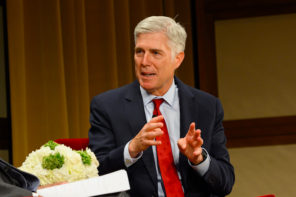With Kim Davis and representatives of the Little Sisters of the Poor both trotted out as as GOP guests at President Obama’s state of the union speech, it’s clear that “religious freedom” is here to stay as an animating issue for the Republican Party. And with Religious Freedom Day approaching this Saturday, January 16, advocates are warning of a continued expansion of “religious freedom” exemptions that threaten reproductive and LGBT rights—as well as the rights of employees of faith-based institutions.
In a new report on the religious freedom strategy of the religious right, Frederick Clarkson of Political Research Associates warns that the Christian Right, the U.S. Catholic bishops, and a rapidly strengthening network of allied organizations are “intensifying their campaign to carve out arenas of public life where religious institutions, individuals, and even businesses may evade civil rights and labor laws in the name of religious liberty.”
This alliance is working to create “zones of legal exemption,” according to Clarkson, by building on the success of high-profile religious freedom cases like Hobby Lobby, “religifying” organizations so they qualify for ministerial exemptions, passing state-level Religious Freedom Restoration Acts (RFRAs), advocating for new individual exemptions like that sought by Davis from issuing same-sex marriage licenses, and making religious liberty claims in local zoning cases under the Religious Land Use Institutionalized Persons Act.
“These overlapping exemptions threaten to give rise to theocratic zones of control,” warns Clarkson, as the right seeks “to minimize its losses and consolidate its reserve strengths.”
As religious freedom claims proliferate, he warns, they threaten to impinge on everything from women’s access to reproductive health services, to the right of LGBT couples to adopt children, with Michigan recently passing a law that allows faith-based adoption agencies (which account for nearly one-third of the state’s adoptions) to decline to place children with couples on religious grounds. They also threaten nondiscrimination protections for employees of faith-based organizations such as Catholic schools as they categorize more employees as “ministers” to evade employment protections.
And in one of the more egregious examples of the proliferation of these claims, a health care system in New Jersey recently tried unsuccessfully to justify the underfunding of its employee pension plan with a religious liberty claim.
Central to the success of the religious liberty strategy notes Clarkson is a dramatic increase in the institutional capacity of a network of conservative public interest law firms, law schools, and educational and political institutions like the Becket Fund for Religious Liberty and the Alliance Defending Freedom. Since 2000, ADF’s Blackstone Legal Fellowships have trained more than 1,600 first-year law students in a “distinctly Christian worldview in every area of law, and particularly in the areas of public policy and religious liberty.”
The Liberty Counsel, founded by Mat Staver, the former dean of Jerry Falwell’s Liberty University School of Law, grew by 17 percent between 2010 and 2013 and became a major player with its defense of Davis. It now includes a political action arm called Liberty Counsel Action, one of the sponsors of the Value Voters Summit, which grew 39 percent in two years to become a $2 million organization in 2013.
The battle to expand the scope of religious liberty exemptions has been especially damaging to reproductive rights, according to a new analysis by Adam Sonfield of the Guttmacher Institute. From the proliferation of “conscience clauses” that allow individuals and institutions to refuse to provide reproductive health care, to the continued battle over the contraceptive mandate in the Affordable Care Act, to refusal of the U.S. Conference of Catholic Bishops to provide reproductive health services to victims of trafficking and refugees under federal contracts, women’s health care has been a particular target of religious liberty exemptions.
Sonfield writes that as the concept of religious liberty has become “highly politicized and distorted,” the “concept of balancing competing rights, responsibilities and needs seems to have given way to religious liberty trumping all other concerns.” He says social conservatives are now “using laws like RFRA to erode rights, programs and services that they wish to eliminate entirely but have been unable to do so directly through other means.”
Both Clarkson and Sonfield note that the successful expansion of religious liberty claims is being driven by a distorted notion of religious freedom. Where traditionally religious freedom was defined as an individual’s free exercise of religion and conscience, it’s now being redefined as the right to discriminate and impose a conservative social order in the name of religion.
Clarkson says true religious freedom is only possible within the context of religious pluralism, which is why it’s necessary to avoid the dualistic framing of the right that LGBT and reproductive rights and religious freedom are mutually exclusive. He says this can be done by highlighting religious support for reproductive rights and marriage equality, such as when leaders of the United Church of Christ in North Carolina “successfully challenged the anti-marriage equality amendment to the state constitution on grounds that it criminalized ceremonies which they and other religious communities considered to be valid and sacred.”
Sonfield calls for a “mitigating the harm” approach to religious liberty exemptions that accepts they are the new reality and incorporates specific limits, advance notice requirements and “more explicit guidance and fail-safes” in RFRAs. Clarkson, on the other hand, calls for a broad strategic assault on the perverted concept of religious freedom by an energized coalition of racial equality, feminist, LGBTQ, labor, civil libertarian, and progressive religious constituencies who “embrace, internalize, and articulate religious freedom as a progressive and indeed, as a transcendent value.”




